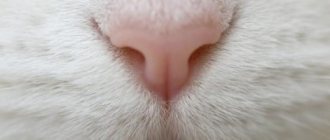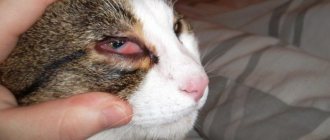Four-legged friends cannot complain about feeling unwell and tell what bothers them and where it hurts. Therefore, breeders carefully monitor the condition of their pets, their mood, appetite and bowel movements.
Blood in a cat's stool is a warning sign. It is necessary to understand the cause and source of bleeding. First, the location of the bleeding is determined by the amount and color of blood in the cat’s stool, and then the root cause is looked for. The veterinarian deals with all this - home diagnostics are impossible, it will only delay time and the cat will get worse.
Reasons for appearance
There are several of them, and blood in the stool can be caused by various diseases and conditions, among the main ones are:
- Parasites. Helminths adhere to the intestinal walls, damaging them, which causes the appearance of bloody discharge with feces. The stool takes on a brown tint.
- Hard feces (constipation) when passing through the intestines can lead to injury.
- Foreign body, for example, a piece of plastic, tubular bone, etc. During a peristaltic wave passing through the intestines, it begins to move, injuring the surrounding tissues, as a result of which blood appears in the animal’s feces.
- Poisoning, for example, with rat poison. If your pet catches rats, mice, or the house has recently been treated for them, the animal may accidentally eat some of it. Once absorbed, the toxic substance leads to poisoning of the body, which is accompanied by bleeding in the gastrointestinal tract and the pet defecates with blood.
- Malignant and benign tumors, as well as the growth of their metastases with germination into the digestive organs.
- Inflammation of the perianal glands (located in the anus area of cats and used to mark territory). With this disease, they increase due to edema, which can develop into a fistula. During the act of defecation, trauma to the inflamed gland occurs and drops of blood appear.
- Coronavirus infection. This virus leads to the development of gastroenteritis, enteritis and peritonitis. As a result of the development of these diseases, damage to the intestinal mucosa occurs and, as a result, diarrhea with blood, vomiting and other signs of the disease. Young animals under 3 years of age and older animals over 10 years of age are most susceptible to infection. Coronavirus infection is a common cause of death for pets; 90% of those infected die. This is a serious condition that requires immediate veterinary attention.
- Problems with the blood clotting system, which leads to intestinal bleeding. In this case, not only feces interspersed with blood appears, but also vomiting with it. This condition can be dangerous for the animal and requires urgent veterinary attention.
- Colitis. Older animals are most susceptible to this problem. The stool changes not only its color, but also its smell. Along with the feces, dark-colored blood and mucus are released, and constipation alternates with diarrhea.
- Poor absorption of dry food. This is often due to the fact that the animal drinks little water after eating such food, which leads to severe compaction of feces, which injure the delicate intestinal mucosa.
- Various diseases of the gastrointestinal tract. Among the main ones are: gastritis, pancreatitis, cholecystitis, peptic ulcer of the duodenum and stomach and many others. With these diseases, the blood in the feces will be dark, even black, in color.
- Long-term constipation leads to the formation of cracks in the anus, and blood is released in scarlet color at the end of the act of defecation.
- Polyps in the colon lead to trauma and bleeding.
- Allergy to stabilizers, dyes and corn flour contained in dry food. The main recommendation for this condition is a partial or complete transition to separately prepared natural food.
- Infection with bacteria, such as salmonella, colibacteria and intestinal tuberculosis. In this case, inflammation of the intestinal mucosa occurs, the permeability of the vessels located in it increases and, as a result, the detection of blood in the cat’s stool.
- Rectal prolapse caused by prolonged labor, constipation or diarrhea due to strong straining of the pet.
This is not the entire list of diseases and conditions that can provoke the appearance of blood in the stool, and the symptoms are similar. Therefore, you should not make a diagnosis and prescribe treatment on your own; it is better to trust a professional – a veterinarian.
Categories of blood in kitten stool
Fecal bleeding usually comes in two main forms, depending on the various sources of disease:
- Hematochezia
Hematochezia, commonly known as bright red blood, is associated with bleeding in the lower intestine, namely the colon and rectum. No case of hematochezia should be taken to heart. However, recurrence of this phenomenon may indicate all the signs of serious health problems, including cancer and parasite infestation in old and young animals, respectively.
© shutterstock
- Melena
Melena, or tarry blood, occurs due to damage in the intestinal tract, especially in the small intestine, where the blood is subject to discoloration as a result of the digestive process due to the action of enzymes found there. This bleeding often occurs in cats' stomach, esophagus, duodenum and, in some cases, the mouth and nose.
Symptoms
The appearance of blood in the stool is always an alarming signal for the owner that the animal requires specialist help.
You should be especially vigilant and see a veterinarian as soon as possible if your pet has the following symptoms, in addition to blood in the stool:
- during the act of defecation, the animal meows heavily - this indicates that it is painful for him to defecate;
- the appearance of vomiting;
- reducing the amount of food consumed until completely giving it up;
- the pet becomes weak, apathetic, stops playing;
- the cat is very worried, meows often - may be associated with pain in the abdominal area;
- rise in body temperature;
- frequent urination;
- the pet begins to drink often and a lot;
- sudden weight loss;
- blood and its clots around the anus.
When pain occurs as a result of any diseases and conditions accompanied by blood in the stool, the animal experiences a severe stress situation, which further aggravates the situation. Therefore, timely treatment is simply necessary for your pet.
Urolithiasis disease
At risk are long-haired cats, neutered cats, and obese animals. Some pets have a genetic predisposition to urolithiasis. But all cats at risk can remain healthy if they do not fall under the influence of certain factors:
- unbalanced diet;
- low fluid intake;
- hormonal disorders;
- avitaminosis.
Most often, urolithiasis is diagnosed in animals in the fall and spring. The cat goes to the toilet with blood in its urine, and its health begins to deteriorate. If treatment is not started immediately, the animal will die with an 80% probability.
The cat needs to be taken to the clinic for examination and diagnosis. If the disease has progressed far, the doctor will insert a catheter into the animal, which will facilitate the passage of urine. Infusions of saline solution through an IV are recommended for a dehydrated cat. During treatment, the furry patient is put on a veterinary diet: Royal Canin Urinari or Hills c/d.
Steps to take before visiting a veterinarian
If blood is found in your pet’s stool, but there are no signs of a serious condition described above, you should observe your pet for a while and find out some points:
- frequency of blood appearance: once or regularly;
- approximate quantity: in the form of drops, veins, clots or completely;
- Has anything changed in the pet’s behavior: has it become restless, sleeps a lot, stopped playing, etc.;
- is there anything in the feces other than blood: hair clots, mucus, undigested food particles, etc.;
- has eating behavior changed, how much water is consumed;
- the presence or absence of vomiting, diarrhea or constipation;
- measure the temperature and check whether it is within normal limits.
All these parameters are very important for making a correct diagnosis and the veterinarian will definitely ask about them.
Diagnosis of the causes of bleeding in cats
In order to make a correct diagnosis, the veterinarian will interview the owner to find out important points in the pet’s life and examine the patient. After this, they move on to diagnostic studies.
For this purpose, the following is carried out:
- general and clinical blood and urine tests;
- coprogram - helps to clarify the presence of undigested food, the presence of blood and other parameters;
- examination of stool for the presence of worms and protozoa;
- Ultrasound of the abdominal organs and kidneys;
- X-ray examination;
- If necessary, a colonoscopy will be performed. This study makes it possible to examine the animal's intestines from the inside.
How to accurately diagnose the disease?
The owner of a cat that poops blood should be prepared for the veterinarian to ask a number of questions. Typically, a standard medical history includes obtaining the following information from the pet owner:
- The cat’s diet, changes in it recently, compliance with the water regime.
- Date of treatment for parasites and name of the drug.
- Associated symptoms (diarrhea, constipation, itching in the anus, increased attention of the cat to this area, etc.).
- Substances and objects that are dangerous to the cat are in the public domain (poisonous plants in the house, household chemicals, trash cans).
- Does the animal have free access to the street?
Cats walking unattended can get injured or poisoned on the street
To identify the reason why there are traces of blood in a cat's feces, a simple examination is not enough in most situations. Usually, veterinarians first prescribe routine tests: general and detailed (biochemistry) tests of blood, urine and feces samples, ultrasound of the abdominal cavity, x-ray examination of the stomach or intestines, colonoscopy.
If these diagnostic methods do not produce results, then they resort to a biopsy - using an endoscope or during surgery, a section of intestinal tissue is taken for analysis. This method allows you to detect neoplasms or chronic severe inflammation (colitis) in the intestines. Note that this technique is rarely resorted to, because the diagnosis is often clear already in the first stages of examining the animal.
Ultrasound of the peritoneum is painless for a cat
Possible treatment
Depending on the reasons that caused the appearance of blood in the stool and the diagnosis, the principles of treatment will differ:
- If this condition is caused by dry food, you should completely abandon it. Dry and canned cat food is the same as fast food for us. Since it contains a large number of dyes, preservatives, thickeners and all kinds of additives that have a bad effect on the pet’s body. But do not forget that feeding from a human table is even more dangerous for your pet. It is necessary to start preparing natural food for him separately. You should consult your veterinarian about products approved for use. The veterinary clinic will help you develop an approximate menu, as the nutrition must be balanced. But there are rules: you cannot give fatty, spicy, salty and sweet foods. You can feed boiled chicken, rice, boiled vegetables. Smecta dissolved in a small amount of water helps to normalize stool. Probiotics will help normalize intestinal microflora. For this purpose, Hilak Forte is prescribed; it is a solution for oral drip use, which makes it convenient for use at home in the dosage specified by the veterinarian.
Read about what cats and cats are not allowed to eat.
- The cause is infection with bacteria or helminths. Antibiotics and antiparasitic agents are prescribed, as well as intravenous infusions of vitamins, microelements and saline. They will help maintain the acid-base balance of the body, reduce intoxication and improve the overall well-being of the cat.
- When problems with the liver and gall bladder are detected, hepatoprotectors are prescribed, for example, Essentiale Forte. It is administered intravenously or subcutaneously, in some cases oral (inside) use is acceptable. You should strictly adhere to the prescribed dose.
- If there are problems with the blood coagulation system, hemostatic drugs and vitamin K are prescribed.
- The cause of bleeding is the excessive accumulation of hair and the formation of lumps from it in the intestines - special medicinal foods are prescribed to help eliminate it naturally.
- If there are problems with the pancreas (pancreatitis), taking enzymes is indicated.
- If tumors, foreign bodies or polyps are detected in the intestines, surgical treatment is mandatory, eliminating the problem radically. Drug therapy in such cases is powerless.
- If an animal is poisoned, wash away its remains from the body by gastric lavage and enema. Intravenous administration of a diuretic and solutions is also prescribed to maintain the acid-base balance of the blood, which promotes a speedy recovery of the pet and improves its overall well-being.
It is worth remembering that the sooner qualified assistance is provided, the greater the chances of recovery.
Coronavirus
The cause of loose stool in a cat may be a viral infection. The disease is extremely contagious and will ultimately lead to the death of the animal. Coronavirus is an infection that causes your white blood cell count to drop. Kittens aged 2.5 to 4 months are most susceptible to the disease. The main source of spread of the disease are animal carriers. These cats once had coronavirus and are now infecting others. In addition to carriers, objects that have been in contact with them pose a danger.
The disease has 2 variations: the first causes enteritis, and the second – viral peritonitis. The causative agents of the disease have a similar structure; one strain can mutate into another. If cats tolerate enteritis well, infectious peritonitis leads to the death of the animal. Young cats are most susceptible to the virus.
Only a veterinarian can make an accurate diagnosis, but based on some symptoms, the owner may suspect his pet has coronavirus:
- redness of the gums;
- loose stools mixed with blood;
- damage to the central nervous system;
- germination of blood vessels in the eyes;
- bloating;
- change in animal behavior.
If a cat goes to the toilet with liquid and blood, the owner should be wary. Treatment consists of giving the animal immune stimulants and controlling symptoms. The veterinarian develops an individual diet for the furry patient. It is currently impossible to cure coronavirus completely.
Prevention
To prevent constipation and other conditions that can cause blood in the stool, you should follow several simple preventive measures:
- Proper nutrition for your pet is the key to a long and healthy life. It is worth giving up canned and dry food and switching to a balanced diet of natural food. At the same time, be sure to dose the food and not let your pet consume it excessively.
- Regular deworming therapy.
- Avoid contact with street animals.
- Make sure your cat always has clean drinking water.
- Give multivitamin complexes prescribed by your veterinarian.
- For diseases of the pancreas and liver - a course of hepatoprotectors and enzymes several times a year as prescribed by a veterinarian.
- When treating your home for rodents, isolate the animal to prevent it from eating the poison.
- Bring him to the veterinary clinic regularly for examination.
- If problems with intestinal microflora are identified, it is mandatory to take probiotics.
1111
Helminths
Veterinary experts recommend treating cats for worms once every 3 months. Moreover, this applies to both animals that are allowed to walk and those that are kept at home. It is generally accepted in society that if a cat doesn’t go anywhere, then there’s nowhere for helminths to come from. This is wrong. Ways to infect a cat with helminths:
- contact with sick animals;
- intrauterine infection by a cat of its offspring;
- contact with contaminated equipment;
- eating raw fish.
Owners can bring helminth larvae and eggs into the house on their shoes. The sick animal gradually loses weight, its fur becomes dull and matted. His immunity decreases, he may experience perverted appetite and bloating. If a cat goes to the toilet with a lot of blood and mucus, then veterinarians will prescribe anthelmintic drugs for treatment.











